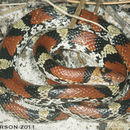en
names in breadcrumbs


Cemophora coccinea, commonly known as the scarlet snake, is a species of nonvenomous snake in the family Colubridae. The species is native to the southeastern United States. There are two subspecies of C. coccinea that are recognized as being valid. The Texas scarlet snake (C. lineri) was previously considered a subspecies.
The scarlet snake is relatively small, growing to a total length (including tail) of 14-26 inches (36–66 cm) at adult size. The dorsal pattern consists of a light gray ground color, with a series of black-bordered red, white or yellow blotches down the back. The belly is either a uniform light gray or white color. The dorsal blotches can extend down the sides of the body, appearing somewhat like banding or rings, which sometimes leads to confusion with other sympatric species such as the venomous coral snakes or the harmless scarlet king snake.[6]
C. coccinea is found only in the United States, in southeastern Texas, eastern Oklahoma, Arkansas, parts of Louisiana, Mississippi, Alabama, Georgia, Florida, South Carolina, North Carolina, Tennessee, Kentucky, Illinois, Indiana, Virginia, Maryland, and Delaware; with disjunct populations in New Jersey and central Missouri. The species is more commonly found throughout most of the Atlantic coastal plain areas. They prefer open forested areas with sandy soil, ground litter, and organic debris.[6]
In Indiana, the scarlet snake is listed as an endangered species.[7] In New Jersey, the scarlet snake has been recommended by the New Jersey Endangered and Nongame Advisory Committee that it be put on the threatened status for this species within the state, but no formal rule proposal has been filed to date. The Threatened status is largely due to population declines and habitat loss. Reasons for the decline in their population are a loss of habitat, illegal capture for the pet trade, road mortality, and direct killing.[8]
The scarlet snake is nocturnal and is active only during the summer months. They can be found during the day beneath logs, under pine debris or other organic litter. They also burrow underground during the daytime hours, or use previously dug tunnels to reside in.[9] At night they are often seen crossing roads, setting out to look for food. C. coccinea's diet consists of lizards, small rodents, the eggs of lizards, turtles, and other snakes. Their large, very sharp posterior teeth are used to slash open large reptile eggs. The snake will either squeeze an egg to expel its contents or thrust its head into the egg to break it open. The smallest reptile eggs are eaten in their entirety.[6]

There is very little known about the reproductive habits of the scarlet snake. It is oviparous, generally laying 2-9 eggs per clutch, with the typical clutch yielding five eggs. Breeding occurs throughout the spring months, and eggs are laid throughout the summer in burrows or under rocks. The eggs hatch two months after breeding, typically in the late summer or autumn.[6]
The natural predators of the scarlet snake are snake-eating snakes such as the coral snake, and predatory birds and mammals. Scarlet snakes rarely bite when picked up by humans, although they can release a foul-smelling odor.[6] The Scarlet snake will use its version of batesian mimicry and mimic the coral snake as a defense mechanism in order to reduce predation, and show predators that it is a venomous species.[10]
The two greatest threats that scarlet snakes face are the destruction of their habitats because of commercial development and the rising rate of road mortality.[6] Other threats are illegal capture of the species for the pet trade and intentional killing.[8]
The following two subspecies are recognized as being valid.[11]
Nota bene: A trinomial authority in parentheses indicates that the subspecies was originally described in a genus other than Cemophora.
Cemophora coccinea, commonly known as the scarlet snake, is a species of nonvenomous snake in the family Colubridae. The species is native to the southeastern United States. There are two subspecies of C. coccinea that are recognized as being valid. The Texas scarlet snake (C. lineri) was previously considered a subspecies.